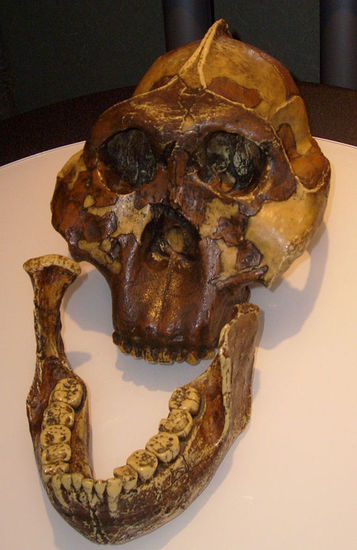The Paradox of the Nutcracker Man
Researchers have assumed Paranthropus boisei used its giant teeth to crack open nuts, but conflicting evidence suggests the hominid ate more like a cow
The large teeth and massive jaw of Paranthropus boisei suggest the hominid ate hard objects, but the chemistry and wear on the teeth indicate the species consumed grasses or sedges. Image courtesy of Wikicommons
It’s not hard to understand why Paranthropus boisei is often called the Nutcracker Man. The hominid’s massive molars and enormous jaw make it seem pretty obvious that the species spent a lot of time chomping on hard nuts and seeds. Yet, the only direct evidence of P. boisei‘s meals—the chemistry and microscopic scratches of the teeth—hint that the species probably didn’t crack nuts all that much, instead preferring the taste of grass. A team of anthropologists that recently reviewed the possible diets of several early hominid species has highlighted this paradox of the Nutcracker Man and the difficulties in reconstructing the diets of our ancient kin.
The first place anthropologists start when analyzing diet is the size and shape of the hominid’s teeth and jaws. Then they look for modern primates that have similar-looking dentition to see what they eat. For example, monkeys that eat a lot of leaves have molars with sharp cusps for shearing the tough foliage. On the other hand, monkeys that eat a lot of fruit have low, rounded molar cusps. If you found a hominid with either of those traits, you’d have a starting point for what the species ate.
But the morphology of a species’ teeth and jaws only shows what the hominid was capable of eating, not necessarily what it typically ate. In some cases, these physical traits might reflect the fallback foods that a species relied on when its preferred foods were unavailable during certain times of the year. Frederick Grine of Stony Brook University in New York and colleagues point this out in their recent review in the American Journal of Physical Anthropology.
Grine and colleagues note that other lines of evidence directly record what an individual ate. One method is to look at the chemistry of a tooth’s dental enamel. As the enamel forms, atoms that an individual consumes become incorporated in the tooth. One of the most common elements to look for is carbon. Because different plants have unique ratios of carbon isotopes based on how they undergo photosynthesis, the carbon isotopes act as a stamp that records what the individual once ate. Researchers look for two main plant groups: C3 plants are trees, fruits and herbaceous plants that grow in environments with cooler seasons while C4 plants are the grasses and sedges that grow in tropical, warm regions. Finding the isotopic traces of C3 or C4 plants in teeth indicate a hominid ate those plants (or animals that ate those plants).
Another way to directly sample diet is to look at the characteristic microscopic markings on a tooth’s surface that form when chewing certain foods. Eating tough grasses and tubers, for example, will leave behind scratches; hard nuts and seeds create pits. One drawback of this method is that a tooth’s microwear is constantly reshaped whenever an individual eats. So, the markings found by anthropologists probably represent an individual’s “last meal,” whatever he or she was eating in the days before death. If a hominid had a diet that changed seasonally, part of the diet may not be reflected in the tooth’s surface wear.
With all of these methods in mind, Grine and his colleagues considered the probable diets of several early hominid species. A comparison of the closely related P. bosei and Paranthropus robustus emphasized the puzzle of the Nutcracker Man.
P. robustus lived in South Africa 1.2 million to 1.8 million years ago when the region was an open grassland. The species’ giant, thickly enameled molars and premolars (better known as bicuspids) and heavy jaw suggest P. robustus was chewing hard objects. The surface wear on the teeth also point to eating hard foods and resemble the wear patterns seen in modern mangabey monkeys, which often eat nuts. The teeth’s enamel chemistry further supports this conclusion: As much as 60 percent of the species’ diet consisted of C3 plants, which would include hard-shelled nuts and fruits (carbon chemistry can’t detect which part of a plant an animal ate).
P. boisei lived in the wooded and open grasslands of East Africa at about the same time P. robustus was alive. It had an even larger jaw and teeth, with the biggest molars of any hominid. These traits indicate the species was a powerful chewer. But the wear patterns on the molar lack the deep pits that characterize those of hard-object eaters. Instead, the patterns match those of gelada baboons, which eat a lot of tough grasses. A grass diet is further hinted at by the carbon isotopes in P. boisei teeth: As much as 77 percent of their diet consisted of C4 plants (grasses and sedges).
Grine and his colleagues suggest there may be a way to reconcile the paradox of P. boisei. Instead of being adaptations to cracking open hard objects, the species’ massive teeth and jaws may have been traits that helped P. boisei handle very abrasive foods, including any grit clinging to blades of grass. Or perhaps the species’ used its giant molars to grind its food in a unique way. These are ideas that anthropologists should further investigate.
Although P. boisei‘s diet seems puzzling, one thing is clear: The apparent mismatch between the various lines of evidence demonstrate that anthropologists still have a lot to learn about what our ancestors ate.
/https://tf-cmsv2-smithsonianmag-media.s3.amazonaws.com/accounts/headshot/science-erin-wyman-240.jpg)

/https://tf-cmsv2-smithsonianmag-media.s3.amazonaws.com/accounts/headshot/science-erin-wyman-240.jpg)